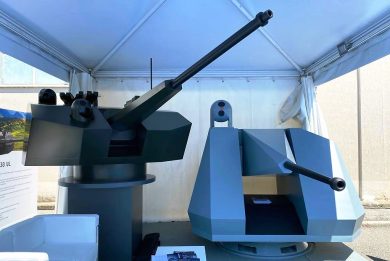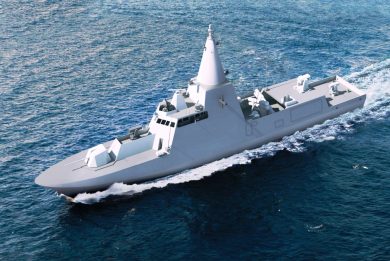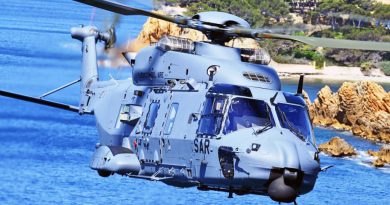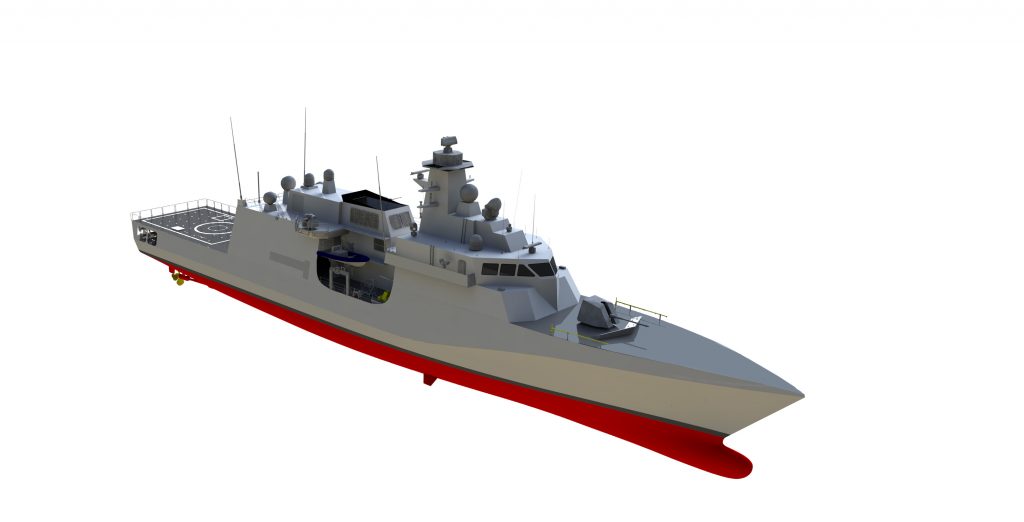
Italy’s new generation OPVs by Orizzonte Sistemi Navali
On 31 July, the Naval Armaments Directorate (NAVARM) of the Italian MoD’s General Secretariat of Defence /National Armaments Directorate assigned Orizzonte Sistemi Navali (OSN), the joint venture between Fincantieri (51%) and Leonardo (49%), a € 925 million contract for the design, construction, and delivery of the first three new generation Offshore Patrol Vessels (OPVs) with related ten-year support. It also includes options for three further units, support and the infrastructural enhancements necessary for the operational bases of Augusta, Cagliari and Messina, divided into different batches.
The new OPVs, previously known as PPX, will gradually replace the two series of Constellation ships better known as Cassiopea- (4 units) and Sirio- (2 units) classes, as part of the Italian Navy’s wider plan to renew its surface patrol component. The latter also includes the Comandanti-class six OPVs that will be replaced under the UE PESCO’s Multi-Mission Patrol Corvettes (MMPCs) also known as European Patrol Corvettes (EPC) programme. The nationally managed new generation OPV programme sees OSN awarding contracts to Fincantieri and Leonardo worth approximately € 540 and € 255 million respectively, pending the approval of the framework contract by the Court of Auditors expected in early autumn. According to OSN, the first-of-class will be delivered in the first half of 2027 if the go-ahead will be obtained at the scheduled date. The programme is planned to last 43 months; the formal go-head (T0) will give the green light for the detailed design phase that will last 11 months, bringing to the first steel cut, delivery being planned 32 months later.
The new platforms
Resulting from the close cooperation between the Italian Navy General Staff and defence industries represented by OSN, the new ships will be able to mainly carry out high seas patrolling contributing to Homeland Security and the protection of national interests in the open spaces seafarers, with a marked propensity for Maritime Interdiction Operations (MIO), without neglecting combat employment profiles and complementary tasks in support of the community, such as the contribution to anti-pollution operations in case of oil spills at sea.
To fulfil these missions, the Italian Navy and Fincantieri selected the FCX20 platform from the new FCX naval ships family, which hull design was developed in 2017-2018 and subsequently refined in 2021-2022 with the aim of guaranteeing excellent sea keeping capabilities, reduced drag and limited RCS and acoustic signatures, the latter characteristics being of particular importance for ‘combat’ versions. The design requires the platform to be able to ensure full operation without restrictions up to Sea State 5 conditions.
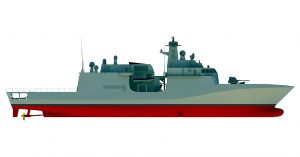
With a full load displacement of about 2,400 tonnes, an overall length of about 95 meters, a maximum beam of 14.2 meters, a construction height of 8.4 meters and a maximum draft of only 5.4 meters to operate from a wide range of harbours. The hull design provides for a bow area with a bulb and a completely covered mooring area to maximize sea keeping performances and ensure protection from bad weather conditions and rough seas, active stabilizer fins amidships contributing to ensure operational capability in high sea state conditions. A large aft area under the flight deck is available to house inflatable floating tanks used to collect the oil recovered via the anti-pollution system or, alternatively and in the event of an emergency, to accommodate a large number of castaways who can be hosted in the large hangar.
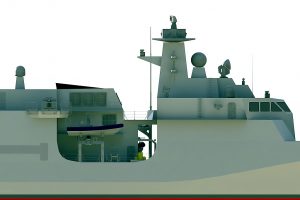
The forward superstructures are characterized by a bridge followed by the combat operations centre (COC) and dominated by the Naval Cockpit which represents the main distinctive feature and innovation derived from the developments of the PPA project, together with the extended bridge wings that ensure practically 360° coverage around the unit. On the main deck amidships, between the two blocks of superstructures, we find the RHIB launch and recovery stations and the equipment intended for anti-pollution operations. The aft area of the new ships is characterized by the flight deck and superstructures incorporating a large hangar to host not only an NH-90 medium-sized helicopter but also an AW Hero-type Class 2 vertical take-off and landing (VTOL) unmanned aerial vehicle.
The CODLAD (COmbined Diesel-eLectric And Diesel) propulsion system is configured on two shaft lines, each including an 8,000 kW diesel engine and a 500 kW reversible electric motor, directly connected to a double input/single output gearbox and variable pitch propellers, while the rudders are of the conventional type. According to requirements, the diesel engines together with the electric ones must ensure a maximum speed exceeding 24 knots. The pace at basic speeds is ensured by electric motors that must be able to ensure a speed of no less than 10 knots. Maximum range is indicated at 3,500 nm at a speed of 14 knots, with a maximum mission endurance of 20 days.
To meet the various speed requirements and reduce fuel consumption and emissions, beside the aforementioned diesel engines and electric motors the design features an electric power generation and distribution plant based on four diesel gensets of around 680-700 ekW each divided in two separate electrical stations. The compartment arrangement for the propulsion and power generating equipment guarantees 50% of the propulsion power with damage to a single compartment and 50% of the electrical power with damage to two contiguous compartments.
The automation and the combat system
The new OPVs have been designed with accommodation for 97 crew members, helicopter/UAV flight detachment and special forces personnel. Although the unit has been conceived with a high degree of automation, to satisfy the requirements in terms of personnel in the event of platform damage, crew rotation, management of mission equipment, armament and on-board maintenance, the crew has been set at around 70 elements.
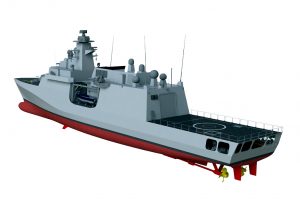
To ensure commonality with Italian Navy’s latest platforms, the new OPVs will be equipped with the same SeasNavy family of ship management system supplied by Fincantieri NexTech, alongside other equipment and a latest generation damage management system. Among the most innovative features, the main one is certainly the Naval Cockpit requested by the Italian Navy General Staff based on the operational experience gained on the PPAs. An integrated station, co-produced by Fincantieri NexTech and Leonardo, it allows the conduct of ship and air-sea operations by only two personnel, the pilot and the co-pilot. Two navy officers can therefore carry out all duties intended for ship conduction and tactical operations. From this position, located on the bridge, it is possible to manage machines, rudders, platform systems, and some combat system functions. Nearly identical to that installed on board the PPAs, keeping the man-machine interface unchanged, the Naval Cockpit is part of a mini combat operational bridge (PLOC) characterized by two stations with fully reconfigurable multi-functional consoles (MFCs) of the combat management system (CMS), which is the same SADOC 4 by Leonardo used from all new Navy units. Behind the PLOC, as on the PPA, we find the Combat Operations Center (COC) that includes three SADOC 4 MFCs and large wall screens. As the ship is designed from the outset for operating a Class 2 VTOL unmanned air system in addition to the NH90 helicopter, the mission planning and control station is co-located with the COC. Following the recent joint presentation between Leonardo, Italian Navy and the Ministry of Defence at Seafuture 2023, the AWHero is expected to be the logical candidate.
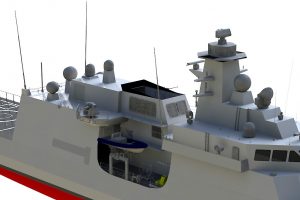
The combat system also features a communications suite supplied by Leonardo with Software Defined Radio (SDR) equipment in V/UHF and HF bands as well as civil/military SATCOM together with the Multi Data Link Processor (MDLP) with Link 22 and Link 16. The sensors suite includes the GEM Elettronica Columbus Mk3 solid-state 3D air and naval surveillance radar with integrated IFF, together with an Elettronica RESM system for electronic surveillance, a Leonardo NA-30S Mk 2 main gun’s fire control system, and two GEM Elettronica Gemini DB in X/Ka band radars for navigation and helicopter control. Panoramic day/night observation and tracking is assured by a Leonardo suite with two Janus EO turrets while two Sitep Italia MASS (Multirole Acoustic Stabilized System) ensure non-lethal close-in defence.
The gun armament includes a Leonardo 76/62 mm Super Rapido and two 30 mm Leonardo Lionfish remote-controlled weapons on platform sides. The main gun comes in the Davide/Strales configuration with the multi-feeder magazine and DART guided ammunition. The gun is also fitted for 76 Vulcano ammunition. The 30 mm Lionfish adoption makes the service the launch customer of the new Leonardo’s gun system, under development together with ABM (Air Burst Munition) ammunition. The Lionfish will be equipped with a day/night electro-optical sensor and laser that, together with the combination of gun and ABM ammunition, will allow to engage and neutralize challenging threats such as drones.
The new OPVs will be equipped with a Solas 7 metres RIHB and a 9.3 metres RHIB, which can also be used to support anti-pollution operations and commercial traffic control. To fulfil the anti-pollution mission, the suite includes two rods for spraying chemical dispersants situated over the bow area, an oil-skimmer module for the recovery of dispersed oil amidships, booms and floating boxes for respectively the containment and confinement of dispersed oil and its storage under the flight deck .
The bivalent ‘patrol/combat’ project nature
The FCX20 project is also conceived and offered as a ‘combat’ unit characterized by a continuous superstructure with covered central boat accommodation areas to reduce the RCS. It can also host a vertical launching system (VLS) for VL MICA or alternatively CAMM-ER surface-to-air missiles, both supplied by MBDA, positioned between the bow-mounted 76 mm Super Rapido and the superstructure, as well as MBDA Exocet anti-ship missiles and a RAMSyS RAM-type close-in defence missile system above the hangar in addition to previously mentioned weapons. As for the combat system, this is centred on Leonardo’s latest generation ATHENA family CMS, the sensor suite including a main radar that for the ‘combat’ configuration would possibly be the Leonardo Kronos Naval HP (High Power), in addition to an Elettronica EW suite with decoy launchers. Obviously, this reference configuration can be adapted based on the specific requests of the customer.
Images courtesy Fincantieri

